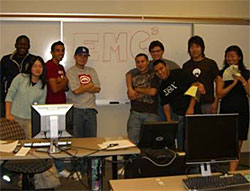 In a collaborative effort between the economics department at CMC and the social science division at the California Institute of Technology, several undergraduate students are gaining valuable experience with the controlled environment that governs laboratory experiments, while earning money for their participation.
In a collaborative effort between the economics department at CMC and the social science division at the California Institute of Technology, several undergraduate students are gaining valuable experience with the controlled environment that governs laboratory experiments, while earning money for their participation.
The project, Experimental Methods at CMC and Caltech (EMC2), offers campus undergraduates the opportunity to participate in computerized economics experiments related to decision-making in markets, auctions, and elections, among others. The student subjects earn real money for participating, based on their choices.
Michelle Goeree, assistant professor of economics at CMC and co-founder of the project together with her husband, Jacob Goeree, professor of economics at Caltech and vice-president of ESA (Experimental Economic Science Association), says more than 40 experiments have been conducted to date. "And we are in the process of developing a database of students who are interested in being involved in the future," says Goeree. "The experiments are in a controlled environment intended for research purposes. We use the results of the experiments to test if economic theories hold up in the lab and to evaluate alternative institutions and policy changes."
Goeree says the project is beneficial to CMC undergraduates in two ways. First, it introduces them to economic research and to the field of experimental economics in general, "something we currently are short on within our faculty," she says. Second, students earn money immediately after the experiment and have the opportunity to contribute directly to research. "The feedback has been uniformly positive," she says.
According to Goeree, the hourly pay rate is not fixed. Each student who participates gets $5 just for showing up, plus the money he or she makes in the experiment (which depends on their decisions, those of others, and sometimes an element of chance). Average earnings are in the $20 to $30 range for a one to one-and-a-half hour experiment, with potential maximum earnings of $50 or more.
Goeree says the big motivation is that students can make real money by making smart decisions, and that the decision-making environment is really interesting. "For example," she says, "they may be traders in a financial asset market, or bidders in an FCC-like auction."
Many of the experiments are guided by important policy questions such as how to improve institutions to more efficiently allocate spectrum licenses or pollution permits. Goeree says that CMC students can play an important role in determining the efficacy of alternative institutions.
The experiments are conducted with the help of nine undergraduates: Nick Yavorsky '07, Felicia Wu, Mickie Betz, and Gwen Kremer, Class of '08, and Freya Lee, Thomas Spiller, Joe Mesa, and Sandra Gomez, all Class of '09, and Kevin Watts, a Caltech student. Yavorsky is scheduled to complete his senior thesisthe first involving experiments run in the EMC2 laboratorythis semester.
To date, over 300 students have been recruited, Goeree says, and we hope to attract at least 500 more. Students interested in participating in the EMC2 program may register at:
http://software.ssel.caltech.edu/recruiting/editSubj.do
Students Earn Cash Through
Economics Experiments
Topics
Contact
Office of Strategic Communications & Marketing
400 N. Claremont Blvd.
Claremont, CA 91711
Phone: (909) 621-8099
Email: communications@cmc.edu
Media inquiries: CMC Media
Email: media@cmc.edu
